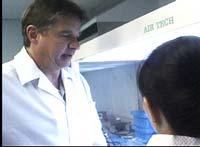|
Like any aspiring astronaut, the RAT must prove it has the right stuff
before it can launch. The Rock Abrasion Tool is the brainchild of Mars
Exploration Rover Principal Investigator , Steve Squyres of Cornell
University, Ithaca, NY. Gorevan of Honeybee says, "Squyres
thought of the need to expose a rock on Mars, and got us from point A to
point B. Our job has been to get from point B to point Z."
After winning the competitive instrument contract, the Honeybee team
has had to follow strict size, mass, and pressure requirements generally
dictated by the strength limitations set by the robotic arm. The Honeybee
team had to use its ingenuity to come up with the optimum way to provide a
mini crater in a martian rock. Gorevan says, "We cobbled and
cogitated together to test ideas, and we're at about point W on the
way to Z."
The RATs in NYC Now Have Motors
 |
 |
|
Steve Kondos |
Rick Paynter |
|
Last week, Steve Kondos and Rick Paynter from JPL hand-delivered to
Honeybee the motors that run the RATS. "We're really conservative
at JPL. The value of the instrument far exceeds the cost," says
Paynter. "We split the motors and carried them in different pieces
of luggage and took separate planes to New York City."
Now that JPL delivered the motors, "we have a clear path to
finish our environmental tests and 'shake and bake' the RAT."
"Shake and bake" is a process used by engineers to ensure
that instruments can withstand the intense vibrations and heat of launch,
the extraordinary impact of landing on Mars, and the strong radiation
exposure during interplanetary cruise. As time races toward launch, other
challenges still remain. "One surprise has been to find how much
dust is created by the RAT," explains Gorevan at Honeybee. As the
robot grinds away at a rock, it generates dust plumes and leaves
RAT "droppings" that can blow onto the solar arrays of the
rovers or the cameras.
"Honeybee's claim to fame in NYC is a long way from its new
role with Mars - they created the giant moving parts on the Coca-Cola sign
in Time Square," says Rick Paynter from JPL. Steve Kondos from JPL
calls the RAT people at Honeybee ingenious. "They are concerned
with cost and schedule milestones, and best of all, they are fun to be
with. Since we come from LA, the Honeybee team introduces us to
little known spots, like a deli where the bread is so good that Frank
Sinatra used to have loaves shipped from Manhattan to Hollywood
every week."
New York, 9/11, and Mars
"After September 11 happened, the first thought was how the team
at Honeybee was affected", explains Kondos. "We called
immediately, but of course couldn't get in contact with them."
Luckily, no one on the team was hurt.
NASA Headquarters just approved putting an American flag on the rock
shield of the Rock Abrasion Tool. "It's not the equivalent of placing
the American flag in the rubble pile, but it's something like that."
Kondos is quiet for a moment, then adds, "We're not stopping our
progress and hiding, we're rising to the stars."
|